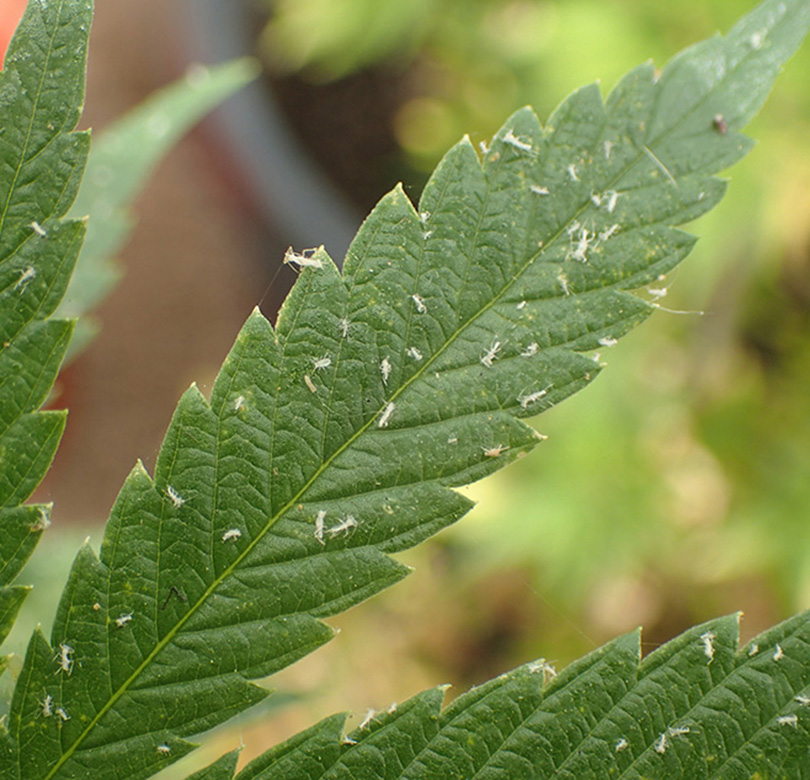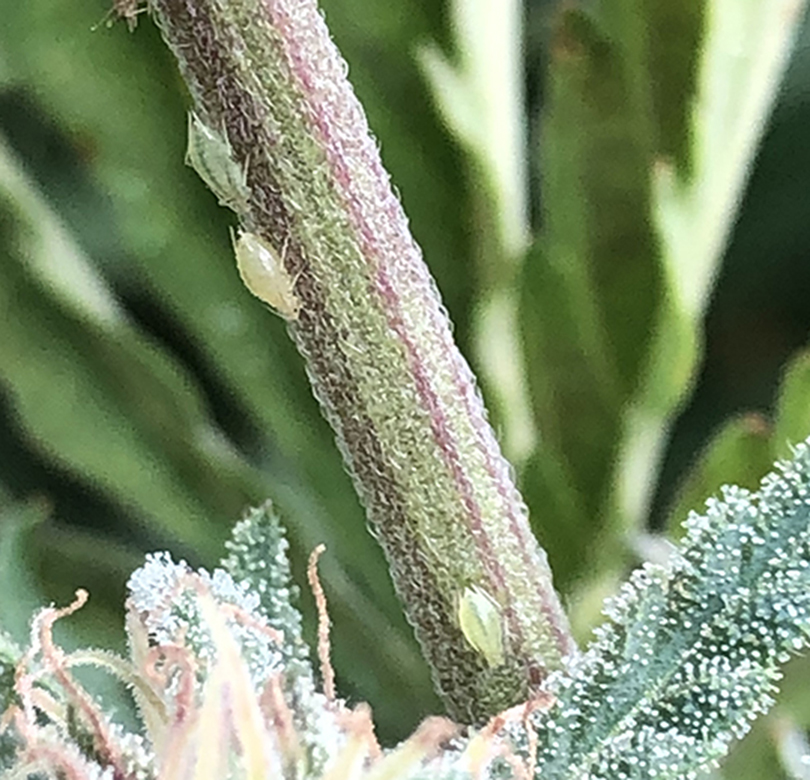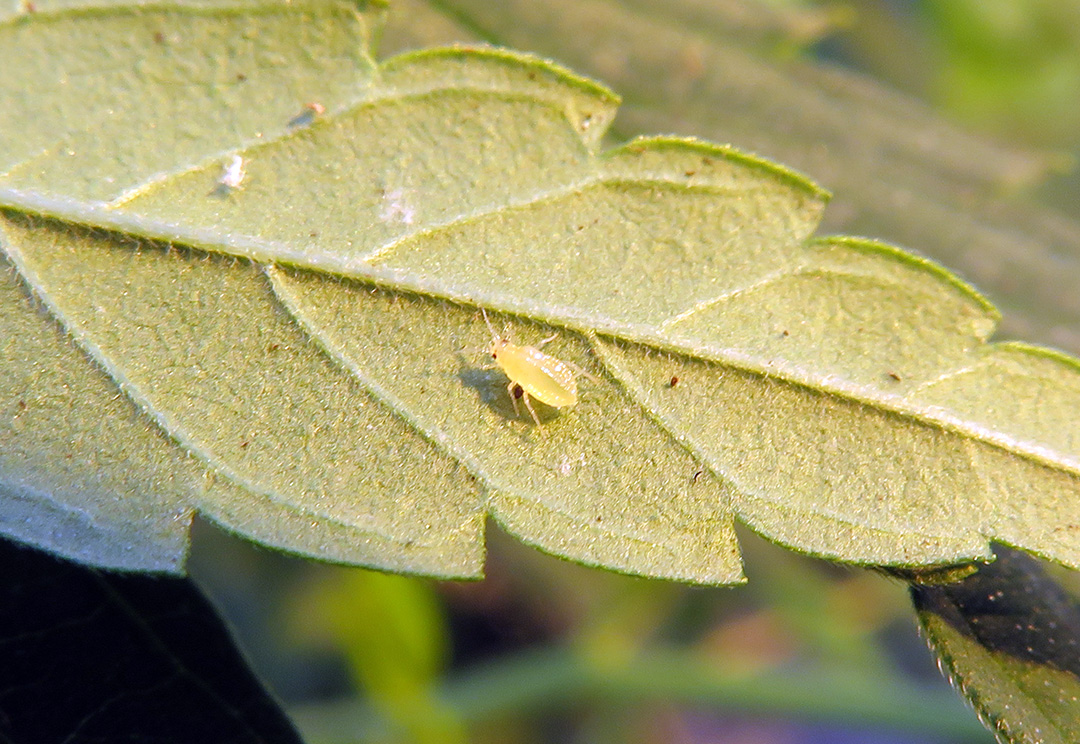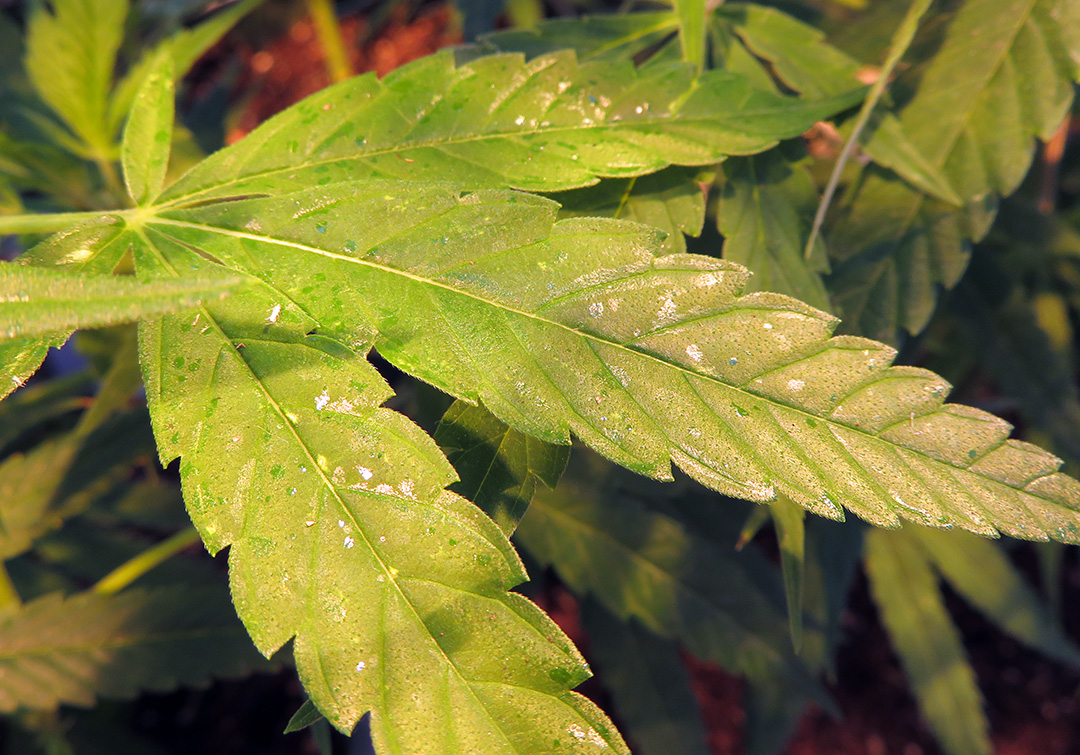Cannabis Aphids
Phorodon cannabis
 Cannabis aphid eggs can range in color from green to black.
Cannabis aphid eggs can range in color from green to black.
Hosts
- Hemp
Description
Aphids can generally be recognized by a pair of cornicles (tailpipelike appendages at the posterior end of the body), a pear-shaped body, and fairly long antennae. Aphid color may vary depending on the season and life stage, ranging from cream and pale yellow (early season aphids) to light green, pale pink, and light brown (late season aphids). Winged aphids may have dark spots on the body and wingless forms may have a pale yellow stripe separated by a thin green stripe along the back. As aphids grow and molt, they leave behind white shed skins.
Biology
Egg | Nymph | Adult (winged or wingless)
- Multiple generations per growing season.
- Aphids give live birth to clones during the growing season (asexual), while eggs are produced in the fall (sexual).
- Overwintering eggs are laid on the host plant or in nearby crop debris in late summer and hatch in the spring.
- Overwintering aphid eggs have a greater success of survival in indoor cultivation.
Damage Symptoms
Adults and nymphs feed on the fluids of host plants using piercing-sucking (straw-like) mouthparts. Under high aphid pressure, leaves will yellow and plant growth will
slow, causing wilting and reduced vigor. The presence of honeydew–a shiny, sticky fluid excreted by aphids–and shed skins, can be diagnostic of infestation. Damage tends to be worse in late summer and early fall as populations build on plants.
Time for Concern
Spring through the end of the growing season.
When and Where to Scout
Inspect the undersides of leaves and along stems throughout the growing season. Survival of the cannabis aphid occurs more commonly indoors. High populations may be seen in outdoor plants in late August and early September.
Threat Level
Will not cause severe economic damage unless present in high populations.
Occurrence in Utah
Typically found in low numbers in outdoor production; higher numbers indoors.
General Management
- Avoid excess nitrogen applications.
- Encourage natural enemies.
- Remove plants in the fall; keep crop areas weed-free.
- Approved insecticides are available, but must contact aphid to be effective.
When to Consider Treatment
If populations are high and causing economic damage.
Look-alikes
hop aphid; other aphids
Insecticides
| Utah-Registered Product | Active Ingredient(s) | Notes |
|---|---|---|
| Bayer Advanced NATRIA Insecticidal Soap Ready-To-Use |
potassium laurate | |
| Bonide All Seasons Horticultural & Dormant Spray Oil Concentrate, Ready to Spray |
mineral oil | Commercial use allowed in greenhouse only |
| Bonide Insecticidal Soap MultiPurpose Insect Control Ready To Use | potassium laurate | Greenhouse use only |
| Bonide Rose Rx 3 in 1 Concentrate | clarified hydrophobic extract of neem o |
Greenhouse use only. |
| Brandt Ecotec Plus | rosemary oil | Greenhouse use only. |
| Bug Buster-O Extinguish Ant Bait | pyrethrins | Greenhouse only |
| Dr. Earth Final Stop OMRI Fruit Tree Insect Killer (RTU); Concentrate |
rosemary oil | Outdoor use only |
| Dr. Earth Final Stop OMRI Vegetable Garden Insect Killer (RTU) |
rosemary oil | Only to non-blooming plants |
| Dr. Earth Final Stop ProActive Yard & Garden Insect Killer (spray) |
rosemary oil | |
| EcoWorks EC | neem oil, cold pressed | |
| Evergreen Crop Protection EC 60-6 | pyrethrins | |
| Garden Safe Brand Insecticidal Soap Insect Killer |
potassium laurate | Outdoor use only. |
| Kopa Insecticidal Soap | potassiums salts of fatty acid |
|
| Mammoth Cancontrol | thyme oil | |
| Mite-E-Oil | mineral oil | Greenhouse use only. |
| M-Pede Insecticide Miticide Fungicide | potassium laurate | Foliar or basal applications. |
| Natural Guard Brand by Ferti-lome Insecticidal Soap Concentrate |
potassium salts of fatty acids |
|
| Natural Guard Brand Neem | clarified hydrophobic extract of neem oil |
Only for outdoor use, or transpalnts intended for outdoor fields |
| Omni Supreme Spray | mineral oil | |
| Organocide 3-in-1 Garden Spray Concentrate, Ready to Spray; Ready to Use |
sesame oil | Greenhouse use only. |
| Organocide Bee Safe 3-in-1 Garden Spray Concentrate; RTU |
sesame oil | |
| Ortho Tree & Shrub Fruit Tree Spray Concentrate |
clarified hydrophobic extract of neem oil |
|
| Prizefighter | ammonium nonanoate | Many uses including greenhouse |
| PureCrop1 | soybean oil | |
| Pycana | pyrethrins | Greenhouse use only. |
| Pyganic Crop Protection EC 1.4 II; 5.0 II | pyrethrins | |
| Pyrethrum TR Total Release Insecticide | pyrethrins | |
| Rango | neem oil, cold pressed | |
| Safer Brand #567 Pyrethrin & Insecticidal Soap Concentrate II |
potassium salts of fatty acids |
Use prior to flowering only. |
| Safer Brand Neem Oil Concentrate | clarified hydrophobic extract of neem oil |
|
| Safer Brand Yard & Garden Insect Killer II |
potassium salts of fatty acids |
|
| SaferGro Pest Out | cottonseed oil | |
| SuffOil-X | mineral oil | |
| Tersus Insecticide | pyrethrins | |
| Triact 70 | clarified hydrophobic extract of neem oil |
|
| Trilogy | sulfur | |
| TriTek | mineral oil | |
| Venerate CG; XC | Burkholderia sp. strain a396 |
|
| Whitney Farms Insecticidal Soap | potassium laurate | |
| Xpectro OD | pyrethrins |
Photo Credits (from top to bottom)
- Whitney Cranshaw, Colorado State University, Bugwood.org
- USU Extension IPM Program
- Whitney Cranshaw, Colorado State University, Bugwood.org
- USU Extension IPM Program
- USU Extension IPM Program
- USU Extension IPM Program






